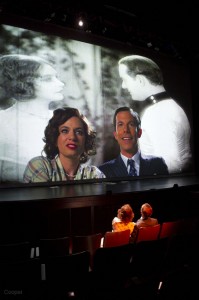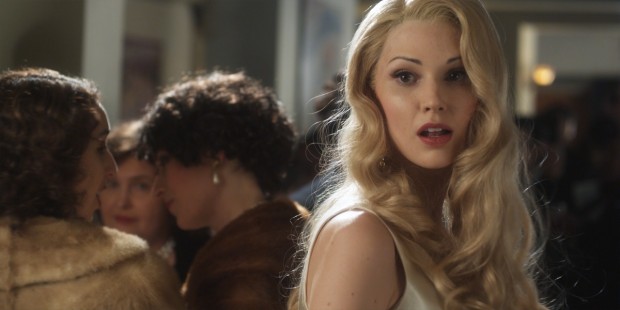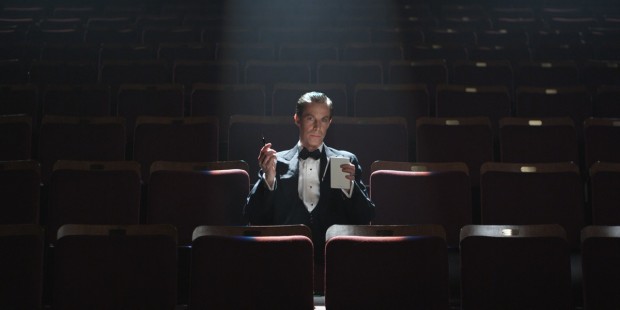Director in Training: Tonight Alex Braithwaite will Tear The Curtain!
by Michael Wheeler
I wonder if this is what embedded journalists feel like?
After two trips to Vancouver to participate in both the filmed and theatrical execution of this project, it is impossible to provide anything approaching an unsentimental analysis of it. I really like the show, the people who made it, and I sincerely hope it comes to Ontario someday so I can show it to people.
I’m sure it will inspire a number of conversations about performance and form: Is it a movie? Is it a play? If it is a hybrid of both, what do you call it? I think it is something else entirely however:
I think Tear The Curtain! is an ode.
The production begins with a film clip of theatre critic Alex Braithwaite being driven to review a performance by his secretary Mavis:
MAVIS
You know what your trouble is?
ALEX
I’m a hack writer living in a hick town.
MAVIS
No.
ALEX
A hick border town where we’re raised on foreign ideas and foreign stories which we imitate, pretending they’re our own… I should have left when I was twenty and gone where the action is.
MAVIS
You just don’t know what you want Alex. I’m sure we may be hicks compared with other places, but don’t deny yourself the privilege that gives you.
ALEX
What privilege?
MAVIS
The freedom to create our own future.
Theatrically, Tear The Curtain goes on to embody this conversation by becoming a piece of theatre that lives within the constraints of this debate by doing something new and exciting, while acknowledging the cultural constraints of living in a city fifty clicks from the United States. Recognizing and integrating the generations of storytellers and shifts in technology that have come before them, the production sets out to be a performance that uses new forms and tools to re-imagine Vancouver within an archetypically American film noir aesthetic.
This is why I think Tear The Curtain an ode. It is not just film noir gangsters, dames, and crazy film integration within a vacuum. It is an ode to the City of Vancouver. It is attached to a particular perspective about what it means to make art in this place, in this era, and everything that generations of artists have gone through to arrive at where they are today.

My part in one of the film clips is so incidental that there are no stills of me with my eyes open. (If you listen very carefully however, you can hear me chuckle at one of Alex Braithwaite's jokes.)
Like the rest of this process, tech at The Stanley Theatre was a whirlwind of activity. What distinguished this week-long period where actors and designers finally integrate their offerings from most, was the extra factors that had to be set in tandem with all the regular ones a director would consider. Each moment is precious in the time you have from when you move into the theatre to to opening night.
Because many of the filmed segments had audio scored directly for the image on the video, but the audio cues for the live action were being set as we established actor blocking, there was a lot to think about in terms of what audio was coming, at what level, and was it attached to the film or called live. Often when audio was activated was related to the fly system for the show, which incorporates three different curtains, a scrim, and a very large wall that are continually emerging from, or disappearing into, the air above the stage
Even the simplest video elements in a performance piece can devour precious tech time, but the scale and resolution of the images captured by the Red camera posed particular challenges for Video Wrangler Michael Sider:

My favourite thing about this scene is that the projected image actually exists legitimately within the given circumstances of the story.
To get the largest, richest image to fill the entire scrim, two identical projectors are broadcasting simultaneously, mounted parallel to one another. These images are also broadcast on different surfaces that are varying distances away from the projectors, so each surface has to have its own focus where the images from the two projectors overlaps correctly.
Separate from projector concerns, once we moved into the theatre, many video sequences needed to have small adjustments made on the fly. A number of factors including small text changes, the timing of scored audio, and blocking adjustments, meant many scenes needed to be shortened or lengthened, or faded in slower or faster, than how we had been working with them back at Progress Lab.
Lighting Designer Alan Brodie faced his own particular challenges working with mixed mediums: The lighting hang used the maximum amount of dimmers available for lighting equipment in The Stanley Theatre. The show requires this many lights because a number of the focuses occur though the light that is video, through or around a scrim, on or within a three-dimensional two-story set, in the house, or any combination of those factors.
Additionally he was charged with using all of this light to maintain a dark, cold, and smoky film noir aesthetic already captured by cinematographer Brian Johnson in the filmed sequences. This had been planned at length in meetings with Director Kim Collier as the three of them established together the visual qualities of the world they would create before either the film or play had been made.
All of these elements are called by Stage Manager Jan Hodgson, who had been practising activating and integrating these elements verbally in the rehearsal hall. Tech involved incorporating new elements and timing as well as actually working with the real things. Most importantly, it was the time to gain an understanding of the rhythm of the show.
There is music to how all these components are related and need to be called. In many ways the art of this production relies on the way the stage manager understands the music the director is playing in all these cues, as much as it does performances on the stage. Although depends a lot on those too. As I put the finishing touches on this piece on a crisp Toronto morning – two days separated from The Electric Company, my thoughts turn to all of the performers in the show:
Today is opening night day! I think the opportunity to be on a stage like doing this show, at this place and time, has a lot to do with why performers gravitate to the theatre, and this is ultimately why Tear The Curtain is a piece of theatre (in the form of an ode). You will never get that feeling on a film set; you have to be there alive in that room with the other people who have chosen to be there, to know what it is. Wish I could be there to share it with them.
Merde!








Recent Comments